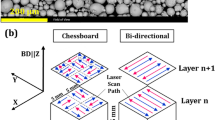Abstract
Linear flow splitting is a new cold forming process for the production of branched sheet metal structures in integral style. It induces extremely high deformation degrees without formation of cracks in the split sheets due to hydrostatic compressive stresses. Investigations on a HSLA steel (ZStE 500) show the formation and fragmentation of a dislocation cell structure in the severely deformed regions of the steel sheet. This results in ultrafine-grained microstructures and improved mechanical properties, similar to SPD processes as Equal Channel Angular Pressing (ECAP) or High Pressure Torsion (HPT). EBSD measurements reveal a gradient in grain size with an increase in direction perpendicular to the surface, whereas micro hardness decreases in the same direction. Based on these results, basic principles of linear flow splitting and its expected potential are discussed.











Similar content being viewed by others
References
Valiev RZ, Estrin Y, Horita Z, Langdon TG, Zehetbauer MJ, Zhu YT (2006) JOM 58:33. doi:https://doi.org/10.1007/s11837-006-0213-7
Furukawa M, Horita Z, Nemoto M, Langdon TG (2001) J Mater Sci 36:2835. doi:https://doi.org/10.1023/A:1017932417043
Tsuji N, Saito Y, Utsunomiya Y, Tanigawa S (1999) Scripta Mater 40:795
Zhilyaev AP, Nurislamova GV, Kim B-K, Baró MD, Szpunar JA, Langdon TG (2003) Acta Mater 51:753. doi:https://doi.org/10.1016/S1359-6454(02)00466-4
Iwahashi Y, Horita Z, Nemoto M, Langdon TG (1997) Acta Mater 45:4733. doi:https://doi.org/10.1016/S1359-6454(97)00100-6
Hughes DA, Hansen N (1997) Acta Mater 45:3871. doi:https://doi.org/10.1016/S1359-6454(97)00027-X
Pragnell PB, Bowen JR, Gholinia A (2001) In: Dinesen AR, Eldrup M, Juul Jensen D, Linderoth S, Pederson TB, Pryds NH, Schrøder Pedersen A, Wert JA (eds) Proceedings of the 22nd Risø international symposium on materials science, Risø National Laboratory, Roskilde, Denmark, p 105
Zhu YT, Lowe TC, Langdon TG (2004) Scripta Mater 51:825. doi:https://doi.org/10.1016/j.scriptamat.2004.05.006
Valiev RZ, Islamgaliev RK, Alexandrov IV (2000) Prog Mater Sci 45:103. doi:https://doi.org/10.1016/S0079-6425(99)00007-9
Groche P, Vucic D, Jöckel M (2007) J Mater Process Technol 183:249. doi:https://doi.org/10.1016/j.jmatprotec.2006.10.023
Groche P, Ringler J, Vucic D (2007) Key Eng Mater 344:251
Müller C, Bohn T, Bruder E, Bruder T, Landersheim V, el Dsoki C, Groche P, Veleva D (2007) Mat-wiss u Werkstofftech 38:842. doi:https://doi.org/10.1002/mawe.200700210
Kim HS, Ryu WS, Janecek M, Baik SC, Estrin Y (2005) Adv Eng Mater 7:43. doi:https://doi.org/10.1002/adem.200400146
Tsuji N, Ito Y, Saito Y, Minamino Y (2002) Scripta Mater 47:893. doi:https://doi.org/10.1016/S1359-6462(02)00282-8
Wang YM, Ma E (2004) Mater Sci Eng A 375–377:46
Shin DH, Park K-T (2005) Mater Sci Eng A 410–411:299
Acknowledgements
The investigations presented in this article are supported by the German Research Foundation (DFG). The authors thank the DFG for funding the subproject C1 of the Collaborative Research Center 666 “Integral sheet metal design with higher order bifurcations—Development, Production, Evaluation”.
Author information
Authors and Affiliations
Corresponding author
Rights and permissions
About this article
Cite this article
Bohn, T., Bruder, E. & Müller, C. Formation of ultrafine-grained microstructure in HSLA steel profiles by linear flow splitting. J Mater Sci 43, 7307–7312 (2008). https://doi.org/10.1007/s10853-008-2682-2
Received:
Accepted:
Published:
Issue Date:
DOI: https://doi.org/10.1007/s10853-008-2682-2




